The Teacup Galaxy (Teacup AGN, SDSS J1430+1339) is a massive quasar – an exceptionally luminous active galactic nucleus (AGN) powered by a supermassive black hole – located 1,100 million light years away in the constellation Boötes (the Herdsman). The active galaxy has an extended loop of gas that gives it the appearance of a teacup.
The Teacup Galaxy is classified as a Seyfert 2 galaxy. The radio-quiet galaxy has an asymmetric structure with a prominent bulge. It contains a shell-like structure, dust lanes, and a tidal tail, which indicate a gas-rich merger of two galaxies. The shell-like feature appears at a radius of 10 arcseconds on the opposite side of the tidal tail. Similar configurations with a single shell are typically seen in galaxies early in the post-merger phrase. The complex dust features are particularly prominent southeast of the galactic nucleus, where they spiral out to a distance of 3.3 kiloparsecs (10,764 light-years).
The Teacup quasar is surrounded by expanding gas bubbles driven by powerful winds from the central supermassive black hole. The shape of the bubbles is altered by a compact jet only detected at radio wavelengths. The radio jet in the galaxy’s central regions is also responsible for increasing the temperature of the surrounding gas. The wind of material that is blowing from the central black hole is producing the teacup shape.
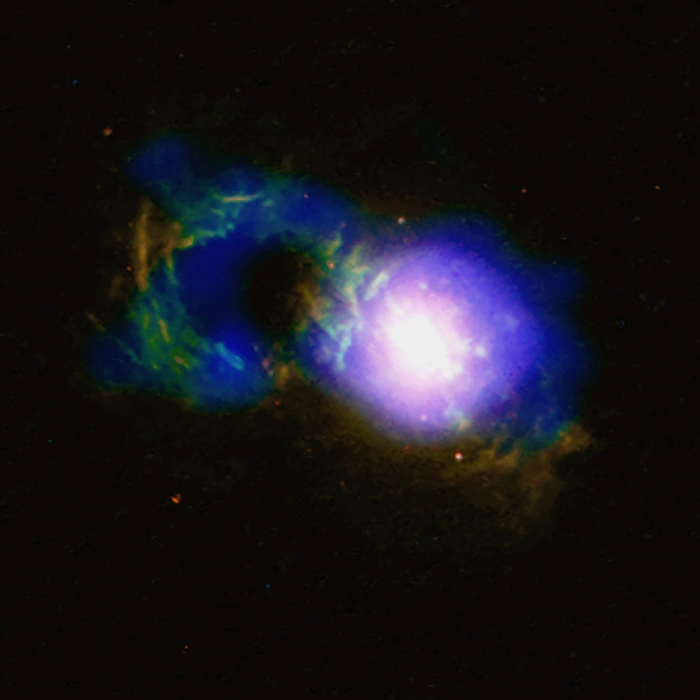
Fancy a cup of cosmic tea? This one isn’t as calming as the ones on Earth. In a galaxy hosting a structure nicknamed the “Teacup,” a galactic storm is raging. The source of the cosmic squall is a supermassive black hole buried at the center of the galaxy, officially known as SDSS 1430+1339. As matter in the central regions of the galaxy is pulled toward the black hole, it is energized by the strong gravity and magnetic fields near the black hole. The infalling material produces more radiation than all the stars in the host galaxy. This kind of actively growing black hole is known as a quasar. This composite image contains X-ray data from Chandra (blue) along with an optical view from NASA’s Hubble Space Telescope (red and green). The “handle” of the Teacup is a ring of optical and X-ray light surrounding a giant bubble. This handle-shaped feature, which is located about 30,000 light-years from the supermassive black hole, was likely formed by one or more eruptions powered by the black hole. Radio emission — shown in a separate composite image with the optical data — also outlines this bubble, and a bubble about the same size on the other side of the black hole. Image credit – X-ray: NASA/CXC/University of Cambridge/G. Lansbury et al; optical: NASA/STScI/W. Keel et al (CC BY-SA 3.0 IGO)
The loop-shaped emission line structure that looks like the handle of the teacup extends up to 12 kiloparsecs (39,139 light-years) northeast of the active galactic nucleus. The bubble was created by a powerful outflow of energy and particles from the central supermassive black hole. The giant outflow that surrounds the nucleus has been proposed to be generated by an AGN wind or by a radio jet about 1 kiloparsec (3,262 light-years) across. The effects of the radio jet are noticeable at a distance of up to 10 – 12 kpc from the nucleus. They may also be responsible for the bubble-like structure that gives the galaxy its nickname.
The low-redshift, radio-quiet quasar was discovered by volunteers of the Galaxy Zoo project using data from the Sloan Digital Sky Survey (SDSS) in 2011. The volunteers detected one of the galaxy’s bubbles in SDSS images. The bubble appeared as a loop of ionized gas about 5 kiloparsecs across.
Galaxy Zoo is a crowdsourced citizen science project that enlists volunteers to assist in the classification of galaxies. The Teacup AGN was discovered during a search for active galactic nuclei (AGNs) with extended emission-line regions (EELRs) similar to Hanny’s Voorwerp, a quasar ionization echo in the constellation Leo Minor (the Lesser Lion), discovered by a Dutch schoolteacher in 2007.
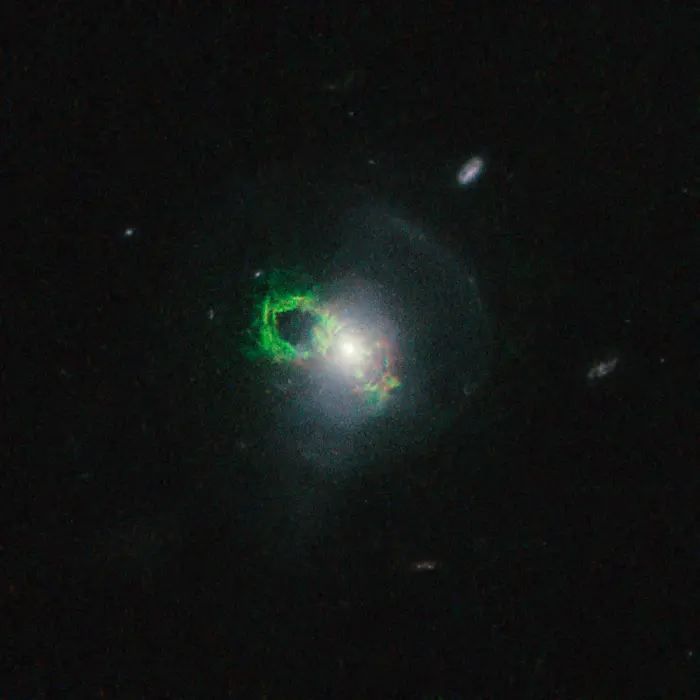
Teacup Galaxy (SDSS), image credit: NASA, ESA, and William Keel (PD)
The Teacup Galaxy is considered one of the Voorwerpje (Dutch for “small objects”), small objects consisting of clouds ionized by active galactic nuclei. In 2012, Galaxy Zoo participants reported the discovery of 19 galaxies labelled as Voorwerpje. These galaxies contain clouds photoionized by AGNs that extend to beyond 10 kiloparsecs (32,615 light-years).
In 2014, a team of astronomers analysed spectroscopic data obtained at the Lowell, Lick and KPNO observatories and found that the loop in the Teacup Galaxy is dominated by emission lines, including hydrogen alpha and doubly ionized oxygen. The team reported that the emission of singly ionized oxygen (O II) is exceptionally strong in the nucleus.
The astronomers also found that the Teacup quasar is gradually fading at a rate that appears to have increased in the last 46,000 years. During this period, the luminosity of the AGN appears to have decreased by around 2 orders of magnitude.
In 2014, integral-field spectroscopy revealed that the large emission-line loop in the galaxy coincides with a radio-continuum structure. Astronomers also identified an outflow region near the galaxy’s nucleus.
In 2014, imaging with the Hubble Space Telescope (HST) allowed astronomers to identify several candidate star clusters in the galaxy. The clusters appear within the inner 5 arcseconds. Most of them are concentrated in a clump 3.5 arcseconds east of the nucleus or aligned with the dust lane. Astronomers suggested that the clump may be a background galaxy.
A 2015 study led by Christopher Harrison of Durham University in the UK analysed radio images obtained with the Very Large Array (VLA), optical data collected with the Integral Field Unit (IFU) of ESO’s VIsible MultiObject Spectrograph (VIMOS) and archival Hubble imaging, and identified bubbles of radio emission stretching 10 – 12 kpc east and west of the Teacup AGN. They reported that the bipolar radio bubbles appear to be inflated by the central active galactic nucleus.
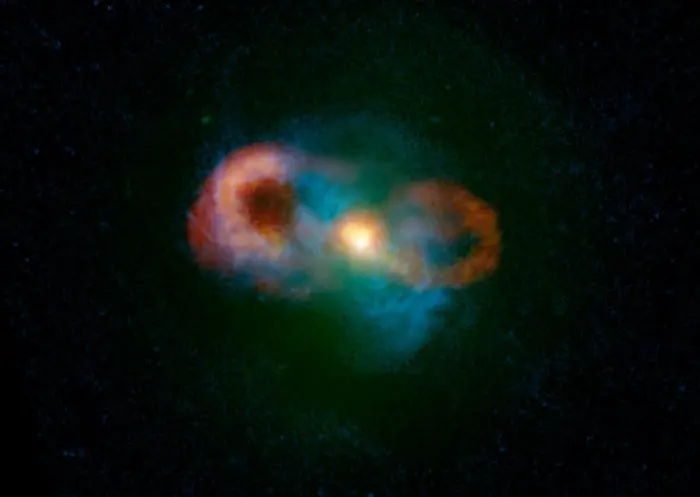
In this composite image of the Teacup Galaxy, the green colors show the starlight, the blue colors show the gas and the red/yellow colors show the radio emission. The bright yellow blobs in the center of the image show where the radio “jets,” launched by the black hole, are driving into the gas and accelerating it to 1,000 km/s (200,000 miles per hour). The giant bubbles also are being inflated by the central black hole. This demonstrates that the central black hole is having a dramatic effect on its home galaxy. Credit: Credit: C. Harrison, A. Thomson; Bill Saxton, NRAO/AUI/NSF; NASA (CC BY 3.0)
The scientists also demonstrated that the nucleus contains a compact radio structure at the base of the eastern bubble, about 0.8 kpc from the core. They found the radio structure to be co-spatial with an ionized outflow with a velocity of 740 km s-1 and proposed that it likely corresponds to a jet or a quasar wind that interacts with the interstellar medium. The jets or quasar winds are directly accelerating gas and likely driving the radio bubbles.
The relativistic jet is produced by energy released from the active galactic nucleus. It travels at velocities close to the speed of light.
In 2017, observations with the Spanish Gran Telescopio Canarias (GTC) in the Canary Islands revealed a giant ionized nebula stretching around 111 kiloparsecs (362,000 light years). The nebula is one of the largest known around any active galaxy. Astronomers believe that it is part of the circumgalactic medium of the galaxy that hosts the Teacup quasar. The medium also contains tidal debris, which indicates past galactic interactions. The galaxy’s optical and radio bubbles are expanding across the medium and affecting its overall kinematics.
Extended ionized nebulae are not unusual around radio quiet quasars. Several giant nebulae have been detected around active nuclei. However, nebulae larger than 100 kiloparsecs are very rare among low-redshift galaxies.
In 2017, a team of astronomers led by Cristina Ramos Almeida of the Instituto de Astrofísica de Canarias (IAC) in Tenerife, Spain, obtained integral field spectroscopy data of the Teacup Galaxy with the SINFONI near-infrared integral field spectrograph on the Very Large Telescope (VLT). The team detected a blueshifted broad component of FWHM~1600-1800 km/s, confirming the presence of the nuclear ionized outflow. The orientation of the outflow coincides with the radio axis, which indicates that the nuclear outflow was triggered by the radio jet.
In 2018, Lansbury et al observed the Teacup Galaxy at X-ray wavelengths. Observations with the Chandra X-Ray Observatory revealed a powerful, highly obscured AGN that is interacting with its host galaxy. The astronomers found that the quasar may not have undergone such dramatic fading. Instead, it dimmed by a factor of 25 or less in the last 100,000 years.
The high-resolution Chandra images showed a prominent loop of X-ray emission stretching to around 10 kpc. The loop coincides with the eastern bubble, which emits strongly at radio wavelengths.
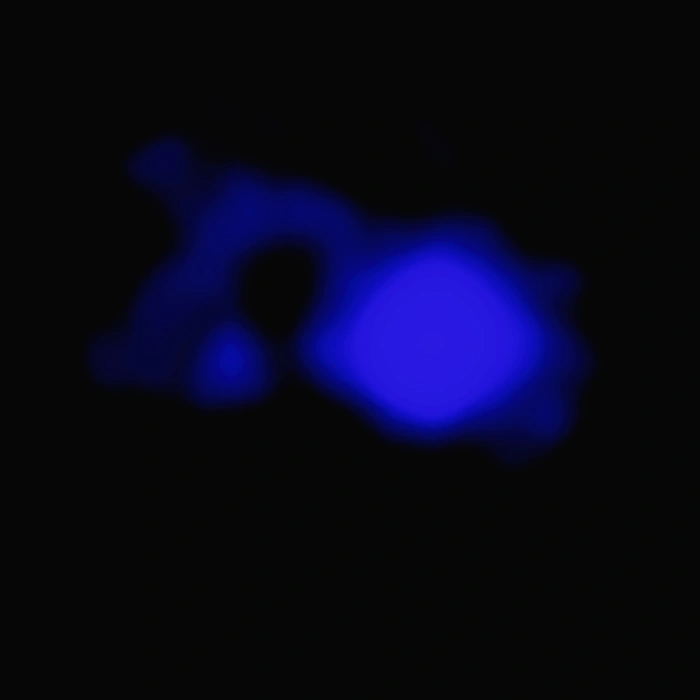
Teacup Galaxy by the Chandra X-ray Observatory, credit: NASA/CXC/Univ. of Cambridge/G. Lansbury et al (CC BY-SA 3.0 IGO)
Data obtained with Chandra and XMM-Newton allowed astronomers to model the spectra of the galaxy’s central quasar. The team found the nucleus to be highly obscured and luminous.
In 2023, an international scientific team led by G. Venturi of the Instituto de Astrofísica in Santiago, Chile, observed the Teacup Galaxy with the MUSE instrument (Multi Unit Spectroscopic Explorer) on the Very Large Telescope (VLT). The team showed that the compact jet significantly perturbs the interstellar medium around the galaxy.
The astronomers also identified a young population of stars with an estimated age of only 100 – 150 million years at the edge of a jet-driven bubble. Their presence indicates that the positive feedback – the compressing effect of the jet and the outflow – may have triggered star formation in the region.
Observations of the emission of carbon monoxide gas in the galaxy with the Atacama Large Millimeter/submillimeter Array (ALMA) in the Atacama Desert in Chile in 2023 showed that the compact radio jet is heating, compressing and accelerating molecular gas, driving a lateral outflow that is perpendicular to the orientation of the jet.
The researchers were able to study the cold, dense gas in the central part of the Teacup Galaxy and characterize it in unprecedented detail. The findings support the thesis that the interaction of the radio jet and the interstellar medium is important for AGN feedback, even in the case of radio-quiet galaxies with low-power jets. Like the powerful jets that dramatically change their surroundings, these relativistic jets can have a surprisingly strong effect on nearby gas and significantly impact the host galaxy’s ability to form new stars. The study was led by IAC researcher Anelise Audibert. It was published in Astronomy & Astrophysics in February 2023.
Location
The Teacup Galaxy lies in the region of the Kite, an asterism that dominates the constellation Boötes. It appears near Zeta Boötis, in the area of the Kite’s tail and tether. The galaxy cannot be observed in small and medium telescopes.
The Kite is a large but not particularly conspicuous asterism in the northern sky. The bright Arcturus, the fourth brightest star in the sky, appears at the base of the asterism. The top part of the star pattern lies between the semi-circular pattern of the Northern Crown and the handle of the Big Dipper in Ursa Major. Arcturus can be found by following the curved line of the Big Dipper’s handle, formed by Alioth, Mizar and Alkaid. Zeta Boötis appears just southeast of Arcturus.
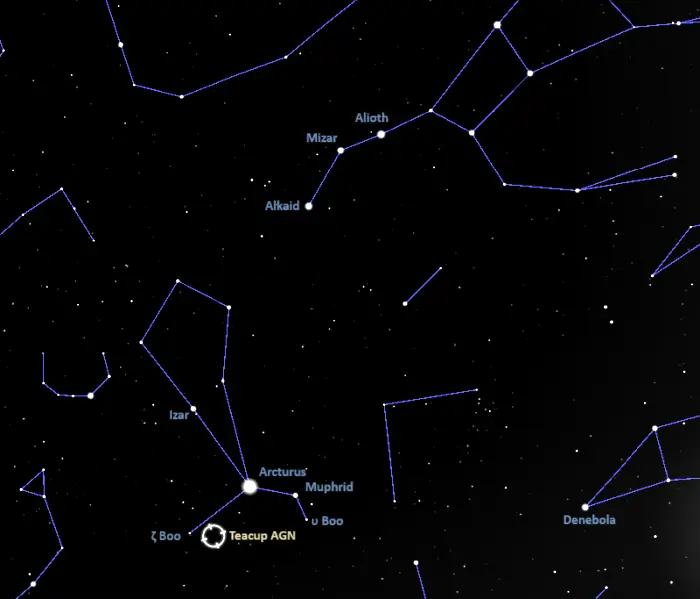
The location of the Teacup Galaxy, image: Stellarium
Teacup Galaxy – SDSS J1430+1339
| Constellation | Boötes |
| Object type | Quasar |
| Right ascension | 14h 30m 29.8820644560s |
| Declination | +13° 39′ 12.007458684″ |
| Apparent size | 0.223′ × 0.197′ |
| Distance | 1,100 million light-years (337.26 megaparsecs) |
| Redshift | 0.08513 |
| Names and designations | Teacup Galaxy, Teacup AGN, SDSS J1430+1339, SDSS J143029.88+133912.0, UVQS J143029.88+133912.0, LEDA 1436754, QSO J1430+1339, NVSS J143030+133912, SWIFT J1430.4+1363, IRAS F14281+1352, 2MASX J14302986+1339117, FIRST J143029.9+133912, NPM1G +13.0377 |